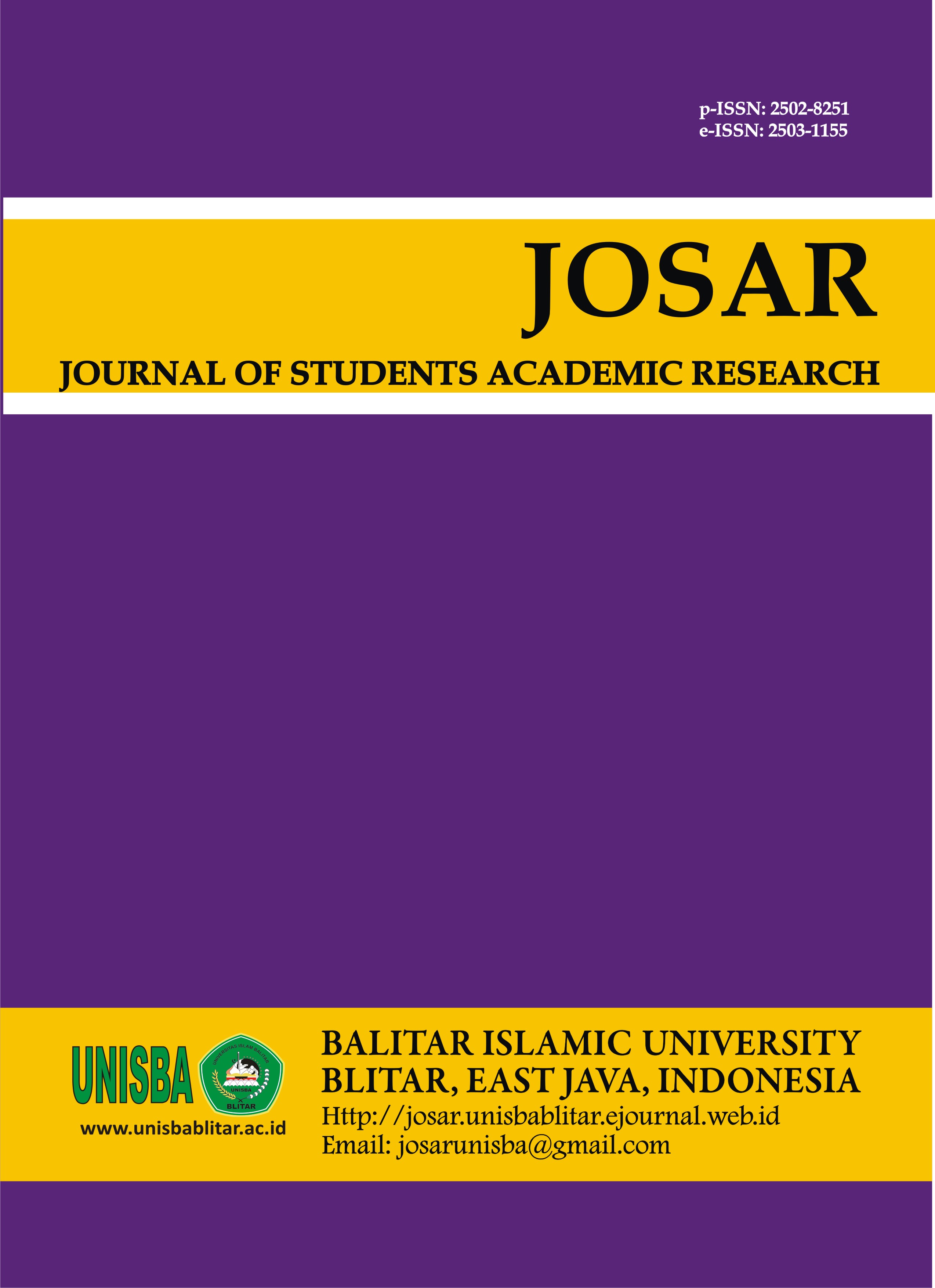CONSTRUCTION OF INDONESIAN LOCAL WISDOM AND TRADITION IN “DELIVERY SUSTAINABLE TOURISM” ADVERTISING
DOI:
https://doi.org/10.35457/josar.v8i1.2118Keywords:
digital advertising, cultural tradition, local wisdom, reality constructionAbstract
One of the variations of contemporary digital advertising is that it contains a description of a society's cultural traditions and local wisdom. Besides aiming to convey a product or service message, the advertisement also aims to promote regional cultural tourism as the advertisement "Delivery Sustainable Tourism" made by the Ministry of Tourism and the Creative Economic of Indonesia. This study aims to determine how the Delivery Sustainable Tourism advertisement on Youtube constructs cultural traditions and local wisdom in Indonesia. This qualitative research uses John Fiske's semiotic analysis method, which categorizes the signs in advertisements into three levels: the level of reality, the level of representation, and the ideology level. The results show traditional constructions and Indonesian local wisdom, including Indonesian hospitality represented by Javanese ethnicity; traditional arts represented by wayang kulit, masks art, and kecak dance; and worship activities represented by Balinese ethnicity. This research concludes that digital advertising constructs the cultural traditions and local wisdom of Javanese and Balinese ethnicities into a representation of cultural realities in Indonesian society with cultural diversity.
References
Achmad, Z. A. (2020). Construct of Women, Violence, and Liberation of Identity in ‘Fiksi.’ Film. LENTERA: Journal of Gender and Children Studies, 2(1), 1–18. Retrieved from https://journal.unesa.ac.id/index.php/JOFC
Achmad, Z. A., & Ida, R. (2019). The shifting role of the listeners in the mediamorphosis process of culture radio: A case study of Jodhipati 106.1 FM. Masyarakat, Kebudayaan Dan Politik, 32(3), 240. https://doi.org/10.20473/mkp.v32i32019.240-250
Achmad, Z. A. (2020). Pergeseran Relasi antara Pendengar Radio dengan Institusi Radio dalam Masyarakat Jaringan (Studi Etnografi Virtual pada Radio-radio Budaya di Jawa Timur yang Bermediamorfosis). Universitas Airlangga.
Achmad, Z. A., Ida, R., & Mustain, M. (2020). A Virtual Ethnography Study: The Role of Cultural Radios in Campursari Music Proliferation in East Java. ETNOSIA: Jurnal Etnografi Indonesia, 5(2), 221–237.
Achmad, Z. A., Ida, R., Mustain, M., & Lukens-Bull, R. (2021). The Synergy of Islamic Da’wah and Madura Culture Programmes on Nada FM Sumenep Radio, Indonesia. Jurnal Komunikasi: Malaysian Journal of Communication, 37(2), 111–129. https://doi.org/https://ejournal.ukm.my/mjc/article/view/37323/12023
Achmad, Z. A., & Juwito. (2020). Sritanjung FM: Mediamorfosis Dari Radioe Lare Using Menjadi Kebanggaan Banyuwangi. Penerbit Sahaja.
Berger, P. L., & Luckmann, T. (1991). The Social Construction of Reality. Penguin Books.
Ibrahim, I. S. (2007). Budaya Populer sebagai Komunikasi. Jalasutra.
Jhally, S. (2017). Advertising at the Edge of the Apocalypse. Department of Communication, University of Massachusetts.
Suwena, I. W. (2017). Fungsi dan Makna Ritual Nyepi.
Wahyuningtyas, D., Kusuma, A., Febrianita, R., & Achmad, Z. A. (2021). Local language programs in cultural radios to maintain Indonesian national identity. Etnosia: Jurnal Etnografi Indonesia, 6(1), 47–65. https://doi.org/10.31947/etnosia.v6i1.11973
Angelina, P. J. (2014). Makna Ruang Ritual dan Upacara pada Interior Keraton Surakarta. Intra, 2(2), 294-301.
Arviani, H., Prasetyo, G. S., & Walgunadi, V. V. (2020). Instagram and Millennial Generation : #Explorebanyuwangi Analysis. 2nd International Media Conference 2019 (IMC 2019) Instagram, 423(Imc 2019), 180–192. Atlantis Press
Fiske, J. (2010). Introduction to communication studies. Routledge.
Hidayat, D. (2013). Permainan tradisional dan kearifan lokal kampung dukuh Garut Selatan Jawa Barat. Academica, 5(2).
Ida, R. (2017). Budaya Global, Modernitas, dan Identitas Budaya: Perspektif Teoritik. In R. Ida (Ed.), Budaya Populer Indonesia, Diskursus Global/Lokal dalam Budaya Populer Indonesia (pp. 18–20). Surabaya: Airlangga University Press.
Ilyas, R., & Nurhidayah, Y. (2019). PENERJEMAHAN TEKS AUDIO VISUAL (SUBTITLING). Jurnal Educatio FKIP UNMA, 5(2), 154-160.
Irfan, M. (2017). Metamorfosis gotong royong dalam pandangan konstruksi sosial. Prosiding Penelitian dan Pengabdian kepada Masyarakat, 4(1), 1-10.
Kotler, P. (2002). Manajemen Pemasaran, jilid 1, edisi milenium. Jakarta: Prehallindo.
Lukitaningsih, A. (2013). Iklan yang efektif sebagai strategi komunikasi pemasaran. Jurnal Ekonomi Dan Kewirausahaan, 13(2), 116-129.
Moriarty, S., Mitchell, N., & Wells, W. (2009). Advertising Seri Kedelapan.
Ngangi, C. R. (2011). Konstruksi sosial dalam realitas sosial. Agri-Sosioekonomi, 7(2), 1-4.
Nurhayati, I. K. (2018). Analisis semiotika John Fiske mengenai realitas bias gender pada iklan kisah Ramadhan Line versi adzan ayah. ProTVF, 2(2), 157-171.
Putra, R. A. (2019). Konstruksi Maskulinitas Laki-Laki Melalui Komodifikasi Tubuh dalam Iklan Produk Susu L-Men Gainmass (Analisis Semiotika John Fiske). Dialogia: Jurnal Studi Islam dan Sosial, 16(1), 43-61.
Sukendro, G. G. (2017, October). Kreativitas Indonesia: Analisis Iklan Pariwisata Indonesia “Pesona Indonesia”. In Prosiding Seminar dan Call For Paper (Vol. 20, p. 21).
Sutrisno, M., & Putranto, H. (2005). Teori-teori kebudayaan. Kanisius.
Tinarbuko, S. (2017). Semiotika Tanda Verbal dan Tanda Visual Iklan Layanan Masyarakat. Panggung, 26(2).
Utami, D. J. (2019). Makna Ritual Melasti Bagi Masyarakat Hindu di Pantai Pasir Putih Lampung Selatan (Doctoral dissertation, UIN Raden Intan Lampung).
Wahyudi, I. (2017). Budaya Populer Global dalam Media Massa Indonesia. In R. Ida (Ed.), Budaya Populer Indonesia, Diskursus Global/Lokal dalam Budaya Populer Indonesia (p. 32). Surabaya: Airlangga University Press.
Wahyuningtyas, D., Kusuma, A., Febrianita, R., & Achmad, Z. A. (2021). Local language programs in cultural radios to maintain Indonesian national identity. Etnosia: Jurnal Etnografi Indonesia, 6(1), 47–65. https://doi.org/10.31947/etnosia.v6i1.11973
Worotitjan, H. G. (2014). Konstruksi Kecantikan Dalam Iklan Kosmetik Wardah. Jurnal e-komunikasi, 2(2).
Downloads
Published
Issue
Section
License
Authors who publish in this journal agree to the following terms:
- Authors retain copyright and grant the journal right of first publication with the work simultaneously licensed under a Creative Commons Attribution License that allows others to share the work with an acknowledgment of the work's authorship and initial publication in this journal.
- Authors are able to enter into separate, additional contractual arrangements for the non-exclusive distribution of the journal's published version of the work (e.g., post it to an institutional repository or publish it in a book), with an acknowledgment of its initial publication in this journal.
- Authors are permitted and encouraged to post their work online (e.g., in institutional repositories or on their website) prior to and during the submission process, as it can lead to productive exchanges, as well as earlier and greater citation of published work (See The Effect of Open Access).
Deprecated: json_decode(): Passing null to parameter #1 ($json) of type string is deprecated in /home/ejournal.unisbablitar.ac.id/public_html/plugins/generic/citations/CitationsPlugin.php on line 68










